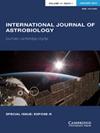航天器组装洁净室细菌群落在富含与火星有关的盐水时的演替
IF 1
4区 物理与天体物理
Q3 ASTRONOMY & ASTROPHYSICS
引用次数: 0
摘要
摘要 星际航天器是在航天器组装设施(SAF)中建造的,该设施是一个洁净室,旨在减少微生物污染,以免干扰生命探测任务或影响本地生态系统。火星寒冷的超干旱近地表环境中有大量吸湿性镁盐和钠盐,如氯化物、(过)氯酸盐和硫酸盐,它们可能潮解形成浓盐水、水活性低的液体,冰点<0°C。目前的研究旨在确定 SAF 地板擦拭样本在盐原培养基中富集 6 个月后的高潮微生物群落,该培养基中添加了 50% (w/v; ~2 M; aw = 0.94) MgSO4 或 20% (w/v; ~1.9 M; aw = 0.91) NaClO3。经过 1 周、4 周和 6 个月的培养后,富集的 SAF 微生物群落的元基因组 DNA 提取物被用于 16S rRNA 基因的高通量测序和随后的系统发育分析。此外,在富集 6 个月后,还从高潮群落中通过重复条纹板法分离出数十种细菌菌株。在富集初期,葡萄球菌在群落中占据了极大的优势,随后仍是群落中的重要成员。然而,随着培养物的成熟,放线菌取代葡萄球菌成为主要类群,其中包括节杆菌、布拉希杆菌和布雷维杆菌。杆菌的种类繁多,其中海洋杆菌尤为丰富。SAF 培养物包括丛生布氏杆菌、沉积布氏杆菌、象鼻海洋杆菌和 sciuri 葡萄球菌。对这些细菌进行了生化和生理测试,结果表明它们具有很强的耐盐性。香农多样性指数一般接近 2,反映了在几个特征层次上的适度多样性,而且整个群落结构参差不齐。不过,群落中的次要成员似乎能够发挥生物地球化学循环所需的生态系统功能。例如,可以检测到具有氮循环所有功能的生物。SAF 中的微生物群落最有可能被航天器带到另一个世界。虽然单个微生物种群可能表现出在火星近表面生存所需的素质,但具有完整生物地球化学循环能力的整个群落肯定会有更大的生存和扩散机会。本文章由计算机程序翻译,如有差异,请以英文原文为准。
Succession of the bacterial community from a spacecraft assembly clean room when enriched in brines relevant to Mars
Abstract Interplanetary spacecraft are built in a spacecraft assembly facility (SAF), a clean room designed to reduce microbial contamination that could confound life detection missions or influence native ecosystems. The frigid hyperarid near-surface environment of Mars has ample hygroscopic Mg and Na salts of chloride, (per)chlorate and sulphate that may deliquesce to form dense brines, liquids with low water activity, and freezing points <0°C. The current study sought to define the climax microbial community after 6 mo of enrichment of SAF floor wipe samples in salt plains medium supplemented with 50% (w/v; ~2 M; aw = 0.94) MgSO4 or 20% (w/v; ~1.9 M; aw = 0.91) NaClO3. After 1 wk, 4 wk and 6 mo of incubation, metagenomic DNA extracts of the enriched SAF microbial community were used for high-throughput sequencing of 16S rRNA genes and subsequent phylogenetic analyses. Additionally, dozens of bacterial strains were isolated by repetitive streak-plating from the climax community after 6 mo of enrichment. Early in the enrichment, staphylococci greatly dominated and then remained abundant members of the community. However, actinobacteria succeeded the staphylococci as the dominant taxa as the cultures matured, including Arthrobacter, Brachybacterium and Brevibacterium. A diverse assemblage of bacilli was present, with Oceanobacillus being especially abundant. The SAF culture collection included representatives of Brachybacterium conglomeratum, Brevibacterium sediminis, Oceanobacillus picturae and Staphylococcus sciuri. These were characterized with biochemical and physiological tests, revealing their high salinotolerance. Shannon diversity indices were generally near 2, reflecting modest diversity at several levels of identity and the community structures were uneven throughout. However, minor members of the community seem capable of the ecosystem functions required for biogeochemical cycling. For instance, organisms capable of all the functions of the N cycle were detected. The microbial assemblage in SAFs is the most likely to be transported by spacecraft to another world. While individual microbial populations may exhibit the qualities needed for survival at the near-surface of Mars, certainly entire communities with the capacity for complete biogeochemical cycling, would have a greater chance of survival and proliferation.
求助全文
通过发布文献求助,成功后即可免费获取论文全文。
去求助
来源期刊

International Journal of Astrobiology
地学天文-地球科学综合
CiteScore
3.70
自引率
11.80%
发文量
45
审稿时长
>12 weeks
期刊介绍:
International Journal of Astrobiology is the peer-reviewed forum for practitioners in this exciting interdisciplinary field. Coverage includes cosmic prebiotic chemistry, planetary evolution, the search for planetary systems and habitable zones, extremophile biology and experimental simulation of extraterrestrial environments, Mars as an abode of life, life detection in our solar system and beyond, the search for extraterrestrial intelligence, the history of the science of astrobiology, as well as societal and educational aspects of astrobiology. Occasionally an issue of the journal is devoted to the keynote plenary research papers from an international meeting. A notable feature of the journal is the global distribution of its authors.
 求助内容:
求助内容: 应助结果提醒方式:
应助结果提醒方式:


